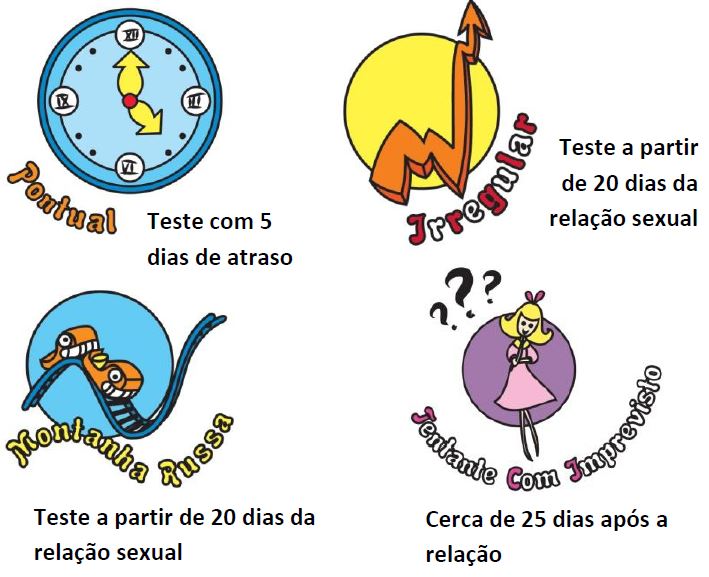Symptoms
When the cycle starts, we women trying to conceive can’t wait for the fertile period to come so we can have sex. Then, it’s all about different positions—one-legged kangaroo here, roast chicken there, and legs up. But what about after the fertile period passes? We just can’t wait for menstruation to be late so we can take a test, even just a pharmacy test to get rid of the anxiety, right?
When symptoms start showing up just two days after the fertile period ends, anxiety only increases. It’s happened to me so many times! Sometimes, the desire is so strong that a woman trying to conceive notices even the slightest symptoms. But don’t think that’s entirely bad, though it’s not all good either, because it can make us even more anxious—and that’s where the risk lies. In these situations, it’s important to know that symptoms very similar to those of pregnancy are common in the days following the fertile period. Recognizing this reality can help keep women grounded and less anxious. When symptoms arrive, so does the urge to take a test; but is it really worth risking a test even before your period is late?
The most common pregnancy symptoms are those many women know by heart, but it’s worth repeating them one more time. The most important are:
- Swelling of the belly and breasts
- Missed period
- Nausea
- Nipple sensitivity
- Cramps
- Increased body temperature
- Light bleeding, pink or brown in color
Most women may experience one, two, or even all of these symptoms and still not be pregnant. The reason is the high levels of post-ovulation hormones. Right after ovulation, progesterone rises to hold the endometrium so the baby can implant and pregnancy can actually happen. Since progesterone is also responsible for all pregnancy symptoms, it can easily confuse a woman. But then, how do you tell the difference between a post-ovulation symptom and the real early pregnancy symptoms?
Most actual pregnancy symptoms persist even after a few days’ delay, that is, if conception and implantation did in fact occur. The symptoms may remain the same or even intensify. Other factors can also play a role in confusing symptoms—such as so-called late ovulation. Late ovulation is nothing more than ovulation occurring much later than expected. For a 30-day cycle, ovulation is expected around day 16. With late ovulation, it can even happen on the day your period is due. Of course, this isn’t a rule—a difference of a week or two or more can occur in women with irregular cycles.
So, the question is: when and how should you take symptoms similar to pregnancy into consideration? When there’s a significant delay compared to your normal cycle! If you have a regular (on-time) cycle, you might find it odd if your period is two or three days late. But women with crazy cycles like mine (rollercoasters) should only consider a delay after the longest cycle you’ve ever had. For instance, if your cycle ranges from 30 to 42 days, you should only think of a possible pregnancy after day 42 of the cycle. It’s not complicated, just find your shortest and longest cycle and that’s it. But it’s better to wait another five days before taking a test.
What should you do if your symptoms continue even after a missed period and the test is still negative? It’s recommended to wait another week and repeat the test because sometimes implantation can take seven to fifteen days to occur. Only after this implantation, called nidation, does HCG, the hormone exclusive to pregnancy, start to be produced. In fact, one of the symptoms of pregnancy is precisely the implantation bleeding, which I’ll discuss more later on. If you repeat the test and it’s still negative, it’s time to see a doctor to investigate the causes. I’ve seen some cases (though not many) of women who do not release HCG in their urine, which makes the test ineffective. In some other rare cases, even a blood test may come back negative even when there is indeed a pregnancy. So, how can you detect a “hidden pregnancy“? Only an ultrasound can provide certainty, and only a doctor can order one.
What could it be if a woman remains late, has symptoms, but all tests and exams are negative? Then the symptoms are hormonal. Usually, the symptoms are caused by high progesterone. If this happens and the period doesn’t show, talk to your gynecologist to treat a possible anovulatory cycle due to hormonal issues. This is completely natural and is no cause for concern.
Pregnancy Tests
So let’s talk about the fun part—the part about tests! I think it’s no secret to anyone that I used to be (maybe I still am) addicted to pregnancy tests—from the pharmacy, of course, because no one likes getting blood drawn two or three times a day! The adrenaline of taking a test was like nothing else. Just thinking about a test, I would go really crazy. My dream was to have a collection, a huge amount so I could take one every day while waiting out the post-ovulation period. It felt like a necessity for me, and all these tests gave me lots of experience with brands, lines of every color, and how, when, and why to take a pharmacy test. I became a kind of expert in them.
My addiction was so big that I used to spend hours looking at pregnancy tests online. In fact, it was the reason I wrote a specific post with photos of tests. It contains some photos of my own tests, some negative with evaporation lines, others faintly positive. There are even some sent by readers who kindly shared their tests to help other women looking for images that might look like theirs, to compare and see if some good news may be on the way in a few weeks.

How many tests did I take per cycle? I don’t remember exactly, but I took five or six before my period was even late. I was always disappointed by the negatives, of course, but also surprised when the positive finally showed up. A weird situation was the positive result for my last pregnancy because I just couldn’t believe my eyes—it seemed like a hallucination or an optical illusion. Funny, right? We wait so much for a positive, but when it happens, it’s hard to believe. It’s like a mirage! Other times, when it’s really negative, we convince ourselves we see an invisible line (that only women trying to conceive can see) on some tests.
I always joke that the amount I spent on tests could have bought a car. Women trying to conceive almost seem like science fiction characters, with all these crazy things! Throw the first stone if you haven’t had your own moment of insanity during that glorious TTC time. Do as I say, not as I did, because you might end up broke. One of these days, I’ll still start ATAVITEG (Anonymous Test-Obsessed Women Trying to Conceive Association).
But really, what are the best tests on the market, that is, the most reliable ones? I have a few favorites, but also suggest avoiding two specific brands because I’ve experienced and seen some false positives with them fairly frequently. One or two faulty tests in a batch can happen, but several? I doubt it, especially in different batches and dates. So, here’s my ranking of the best and worst tests known by me and other TTCers from my nostalgic active days:
| Recommended | mUi | Not Recommended | mUi |
| Baby Sure | 25 | Easy Test | 25 |
| Bioeasy | 10 | Gravtest | 25 |
| Clear Blue (Easy/Compact) | 10/25 | ||
| Confira | 10 | ||
| Confirme | 25 | ||
| Fast Test | 25 | ||
| Maxtest | 25 | ||
| On3 Step | 10 | ||
| Unitest Plus | 10 |
Basically, the pregnancy test detects HCG hormone if there is at least 10mUi present; antibodies are deposited on the positive line, which captures the dye used in the test. If there’s no pregnancy, the dye passes straight through to the control line.
The best tests are not always those with the lowest sensitivity. Some can detect as little as 10mUi of HCG in urine, others (most, actually) detect from 25mUi, which is the standard used by many labs. In my opinion, what really matters is the test’s credibility. Today, I value a good test that gives precise results at an affordable price.
It’s not that the worst tests are all bad, it’s just that if the line is very faint you should be suspicious, because of the history of clear false positives that have happened and still leave trying women confused. Remember, the test instructions say any second line in the test area, no matter how faint, should be considered positive. So, faint lines on pharmacy tests can be a huge disappointment for women hoping for a positive result for so long. Getting a false positive is like having candy snatched from a child’s hands. That’s why trust must be earned through quality.
Pharmacy tests are a good quick solution, especially for women who can’t or don’t want to get a beta HCG (the more accurate test) at the moment. Although we now have increasingly better and more sensitive tests, nothing beats a beta HCG for really detecting a pregnancy. There are two ways to detect pregnancy in blood tests: quantitative beta HCG and qualitative beta HCG. Sometimes, there’s little difference between them, but choosing the right test can be crucial when determining if you’re positive. The qualitative beta HCG works like a pharmacy pregnancy test. But instead of using urine, it uses serum from a blood sample. If a second line appears, it’s positive; if not, it’s negative.
Speaking of negatives, I should mention that false negatives happen too, even to an experienced TTCer like me. If you do the test before the ideal time—that is, before the baby’s implantation begins, which starts HCG production in the blood—the test might not detect a pregnancy, no matter how sensitive it is. Another common problem is evaporation lines that show up after the test dries. These are typically grayish lines that usually only show after the recommended reading time has passed, unless the brand you used is really low quality. I’ve used tests costing R$2 and even the more expensive R$45 ones, but the difference between them is minimal. Many times, a pen test is the same as a strip test—the only difference is the casing.
The safest test is quantitative beta HCG. It can detect even the tiniest amount of HCG in the female body, like 0.01mUi, which is obviously negative. It’s considered positive at around 25mUi, or at some labs only from 50mUi. So, the quantitative test can detect even an early pregnancy, sometimes before a period is late. The best advice is to do a pharmacy or beta HCG test after at least five days of delay. This precaution helps avoid unnecessary disappointment. Trust me, getting a false negative for no reason is really tough on the mind!







